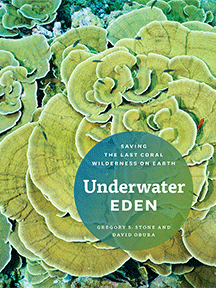By Germaine Cornelissen-Guillaume
Have you ever heard of the Phoenix Islands and the Republic of Kiribati? This little known island nation in the central tropical Pacific Ocean with a population of just over 100,000 on 310 square miles is composed of a raised coral island and a series of atolls dispersed over more than a million square miles. In other words, it is a republic of water. The Phoenix Islands are part of the Tokelau Seamount Chain that emerged from the ocean some 70 million years ago and are among the world’s oldest formations produced by living organisms. This small nation made big news around the world in 2006 when it announced the closing of some of their best coral reefs and tuna fishing grounds to create a marine protected area, the “ocean equivalent of a Yellowstone National Park.”
Gregory S. Stone and David Obura, along with experts in science, underwater photography, conservation, and law, tell the incredible story on how the largest and deepest UNESCO World Heritage Site came into being in a richly illustrated book that offers stunning photographs of marine life, seabirds, and the people from Kiribati. An overall perspective is provided in a foreword written by the President of the Republic of Kiribati.
It all started when explorers sent to search for Amelia Earhart’s lost plane in the Phoenix archipelago realized they had discovered a uniquely pristine ocean wilderness. Subsequent expeditions set out to conduct a systematic exploration of the area, assessing damage caused by commercial fishing boats, invading species, and climate change.
In a conservation effort, responsible ecotourism has been proposed to compensate for lost income from the sale of lucrative fishing rights. Tourist divers turned citizen scientists contribute innovative research and exploration as paying passengers engage in ongoing scientific projects on board the ship. A proposed “reverse fishing license” would also allow the world to pay for the right to protect one of the largest marine protected areas on earth. A $25 million endowment was agreed upon to completely protect seven of the eight Phoenix Islands and associated coral reef systems from commercial fishing. The legal framework was formally enacted in 2008.
This story of a small group of dedicated individuals who by dint of persuasion and perseveration succeeded in establishing the Phoenix Islands Protected Area (PIPA) offers a glimpse of hope for the future of our planet.
Germaine Cornelissen-Guillaume is a professor of integrative biology and physiology and Director of the Halberg Chronobiology Center at the University of Minnesota, Twin Cities.




